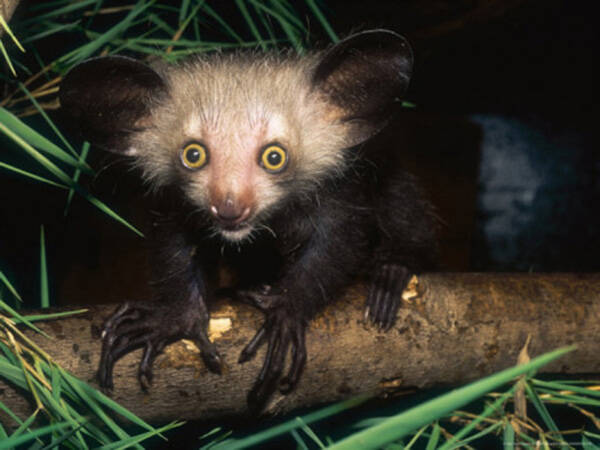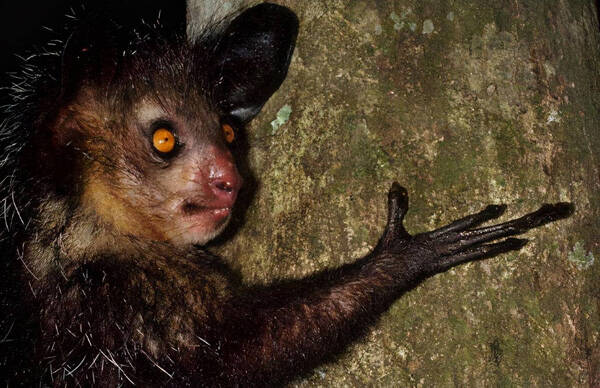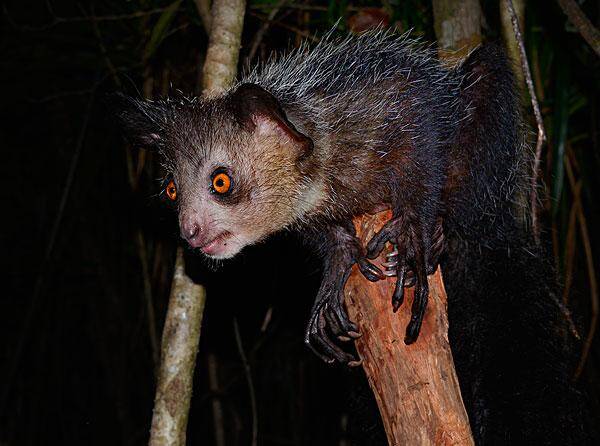Daubentonia madagascariensis
IUCN
LCBasic Information
Scientific classification
- name:Daubentonia madagascariensis
- Scientific Name:Daubentonia madagascariensis,Aye-aye
- Outline:Primates
- Family:Aye-aye
Vital signs
- length:30-38cm
- Weight:2-3kg
- lifetime:About 23 years
Feature
Named for the length of the fingers and toes (middle finger is particularly long)
Distribution and Habitat
The aye-aye was once distributed in the eastern and northwestern parts of the island of Madagascar. It is highly adaptable and lives in a variety of habitats, including primary rainforest, deciduous forest, secondary forest, dry scrubland and mangrove swamps. The species also occurs in what are considered unsuitable habitats, namely the edges of cultivated land. However, these plantations can support multiple individuals if there is also endemic forest nearby.
Appearance
The finger monkey is 30-38 cm long, with a tail length of 44-51 cm and a weight of 2-3 kg. It has a large and flat head, a fox-like face, a prominent nose and snout, a pair of large and active black ears, very large and membranous. It has a slender body, short limbs, and legs longer than arms. Except for the thumb and big toe, which are flat nails, the other fingers and toes have sharp claws. The dark brown body hair is composed of short soft down and thick and long guard hairs, and the snout and lower body are grayish white. The base of the hair on the face and abdomen is white, and the hair on the neck is especially long with white tips. The tail is longer than the body, and the tail hair is fluffy and dense, shaped like a broom, and the hair is up to 10 cm long, black or gray.
The finger monkey is good at appearing at night, with a pair of staring orange-yellow eyes, a big head and a small mouth, a body like a cat, ears like a bat, teeth and claws like a squirrel, and hands like
Details
Daubentonia madagascariensis (scientific name: Aye-aye) is named after the length of its fingers and toes (middle finger is particularly long).

When French explorers first saw the aye-aye in 1780, they thought it was a kind of squirrel. It was not until 1860 that taxonomists dissected and verified that it was a primate. The aye-aye lives on the island of Madagascar on the southeast coast of Africa and is a local specialty monkey.
The aye-aye builds a spherical nest on a large branch or trunk, in a tree hole or on a branch. Different nests will be occupied by different individuals for several consecutive days. They move alone or in pairs at night and hide in trees to sleep during the day. The aye-aye moves on four legs, and jumps on all four limbs when they come down to the ground. When foraging, they use their unique fingers to pick out insect eggs in tree trunks, dig out the pulp from coconut shells, drill eggshells and drink egg whites, and also eat some bark, bamboo, etc. Because the aye-aye likes to eat insect eggs, larvae, and small beetles under the bark or on dead trees, it plays the role of a woodpecker and is a "doctor of trees." There are woodpeckers on the African continent very close to Madagascar Island, but they are replaced by the aye-aye here.
The aye-aye likes to eat insect larvae, small beetles and bird eggs, but not large insects. They also eat sugar cane, mangoes, and cocoa. The aye-aye can use its powerful teeth to bite open the hard shells of fruits such as coconuts. In captivity, they also eat bananas, dates and eggs.

The aye-aye is a solitary nocturnal monkey that hides in its nest during the day. Its nest is mostly built on the top of a tree, with a diameter of up to 60 cm. It is built by cutting tree branches and leaves with its teeth. A tree nest can be lived in for many years. There is no fixed breeding season. The peak of reproduction is in February and March. It reproduces once every two or three years, and produces one cub each time. The gestation period is 160-170 days, and the young are breastfed in the nest for about 2 months. The female aye-aye has a pair of nipples located in the groin of the lower abdomen. Such a low position of the nipples is rare among primates.
When a female is in estrus, it will send out signals to attract males again and again. There can be up to 6 males responding to the call at the same time. Aye-aye is both polygamous and polyandrous. A female can mate with multiple males in estrus. Each mating lasts about an hour, and such a long time may be for males to prevent other competitors from participating. After mating, the female will leave quickly and resume the signal to seduce other males.
The aye-aye has experienced a population decline of more than 50% over a 36-year (three-generation) period, primarily due to continued declines in the size, extent, and quality of habitat, as well as exploitation through unsustainable levels of hunting. These causes have not ceased and are largely not easily reversed. The population is expected to decline by more than 50% over the next three generations due to the same reasons. From 2016 to 2020, the aye-aye has been included in the list of the world's 25 most endangered primates (Randimbiharinirina et al. 2017, 2019). In the future, it is estimated that the species' range will decrease by 43% from 2000 to 2080 due to climate change (Brown and Yoder 2015).
The aye-aye is an animal that is very beneficial to the ecological balance of the forest, but in Madagascar, it is considered an ominous creature by the locals, just like the owl in China, because its cry is unpleasant. The aye-aye's cry is shrill, like crying, which is creepy at night. The aye-aye has a black face and gray body, and its yellow eyes emit a mysterious glow in the night. It jumps like a ghost when it moves, and it has a certain curiosity about people. The locals believe that if the aye-aye jumps on them, it is a sign of death. Therefore, the locals kill the aye-aye when they see it. And nail the aye-aye's body to a wooden stake, hoping that this will drive away the bad luck. Due to the large-scale killing of humans, the number of aye-aye has been decreasing. In addition, after 1500, foreigners such as Indonesia landed on the island and began to cut down forests on a large scale, turning forest land into farms and pastures, so that the forest area here was less than 20% of the original in a very short time, and the habitat of wild animals disappeared instantly. By the 1960s, it was difficult to see the aye-aye. In 1966, two French biologists finally collected 9 aye-aye and released them on Mangobi Island, 5 kilometers northeast of Madagascar. After several searches, people have not seen any traces of wild aye-aye.

Biological scientists have suggested that a systematic census of this important flagship species throughout its range is urgently needed, with the ultimate goal of developing a species conservation action plan. As of 2010, approximately 50 relevant societies are in favor, representing a majority of the various animal conservation groups worldwide (ISIS 2009). There is a captive breeding program involving various institutions, as well as EEP and SSP. This species has not successfully bred a second generation in captivity.
Listed in the IUCN Red List of Threatened Species in 2018 ver3.1 - Endangered (EN).
Listed in Appendix I, Appendix II and Appendix III of the Convention on International Trade in Endangered Species of Wild Fauna and Flora (CITES) 2019 edition.
Protect wild animals and eliminate game.
Maintaining ecological balance is everyone's responsibility!








